Table of Contents
Introduction
Nuts Statistics: Nuts, characterized as seeds enclosed within tough shells, are well-known for their abundant nutritional value, containing protein, healthy fats, and vitamins.
They are available in various types like almonds, walnuts, and cashews, and are widely consumed globally, both as snacks and in culinary uses.
Nuts offer potential health benefits, and their popularity continues to grow. Finding application in diverse culinary creations, including cooking, baking, and as components in various food items.
However, the industry faces challenges like the effects of climate change and concerns related to allergies. Strict regulations govern the nuts market to ensure product safety and quality.
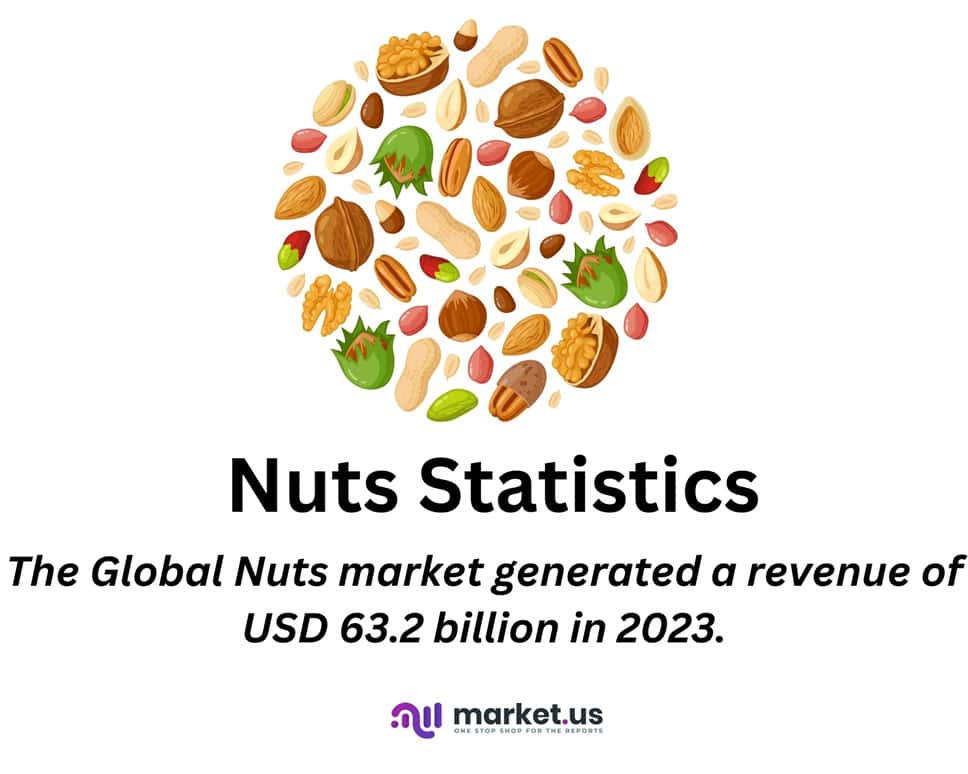
Editor’s Choice
- The Global Nuts market generated a revenue of USD 63.2 billion in 2023.
- Offline distribution, which includes traditional brick-and-mortar stores and physical retail outlets, commands a significant majority with a substantial market share of 84.6%.
- In 2019, North America led the way with a market value of 7,639 million U.S. dollars. This figure steadily increased year by year, reaching 10,764 million U.S. dollars in 2026.
- The 2021-2022 and 2022-2023 seasons saw a decline in almond production, with figures of 1,675,839 metric tons and 1,477,505 metric tons, respectively.
- Notably, in the 2021-2022 season, cashew production witnessed a substantial surge, reaching an impressive 10,86,270 metric tons. This growth trend continued into the 2022-2023 season, with production hitting 10,95,030 metric tons.
- India led the way in cashew consumption, with a substantial 3,22,160 metric tons consumed, indicating a strong affinity for cashews in the Indian market.
- Cashews emerged as the clear winner, with 31.15% of respondents declaring them their top choice.
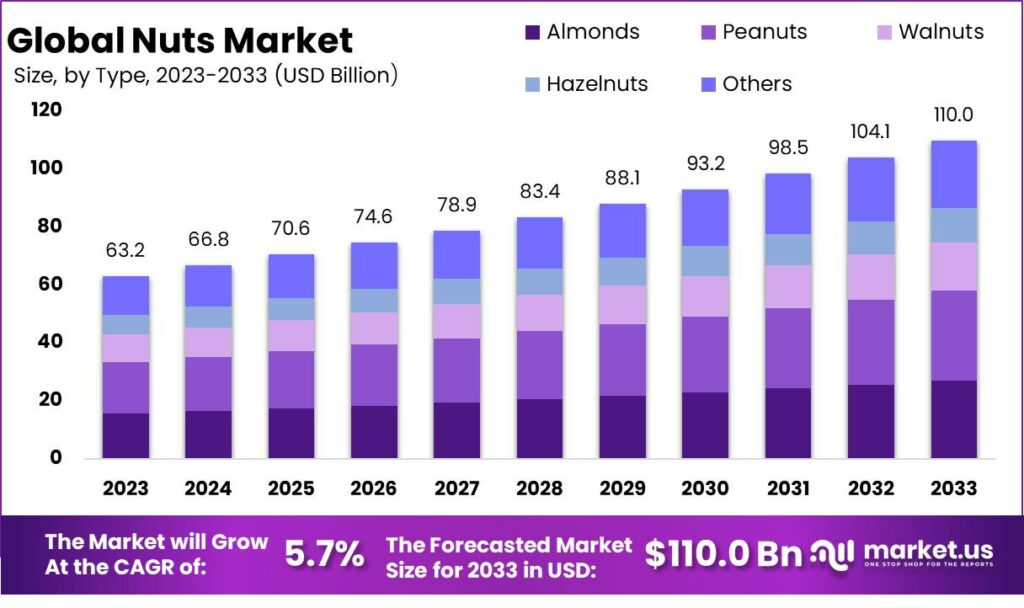
Global Nuts Market Overview
Global Nuts Market Size Statistics
- The revenue of the global nuts market is projected to exhibit steady growth over the coming decade at a CAGR of 5.7%.
- In 2023, the market’s revenue is estimated at USD 63.2 billion, and this figure is expected to rise to USD 66.8 billion in 2024.
- The upward trajectory continues with forecasted revenues of USD 70.6 billion in 2025 and USD 74.6 billion in 2026.
- Over the subsequent years, the market is anticipated to expand further. Reaching USD 78.9 billion in 2027, USD 83.4 billion in 2028, and USD 88.1 billion in 2029.
- The positive trend persists with projected revenues of USD 93.2 billion in 2030 and USD 98.5 billion in 2031.
- By 2032, the global nuts market is expected to reach a revenue of USD 104.1 billion, ultimately surpassing the USD 110.0 billion mark in 2033.
- This consistent growth underscores the promising outlook for the nuts industry in the coming years.
(Source: Market.us)
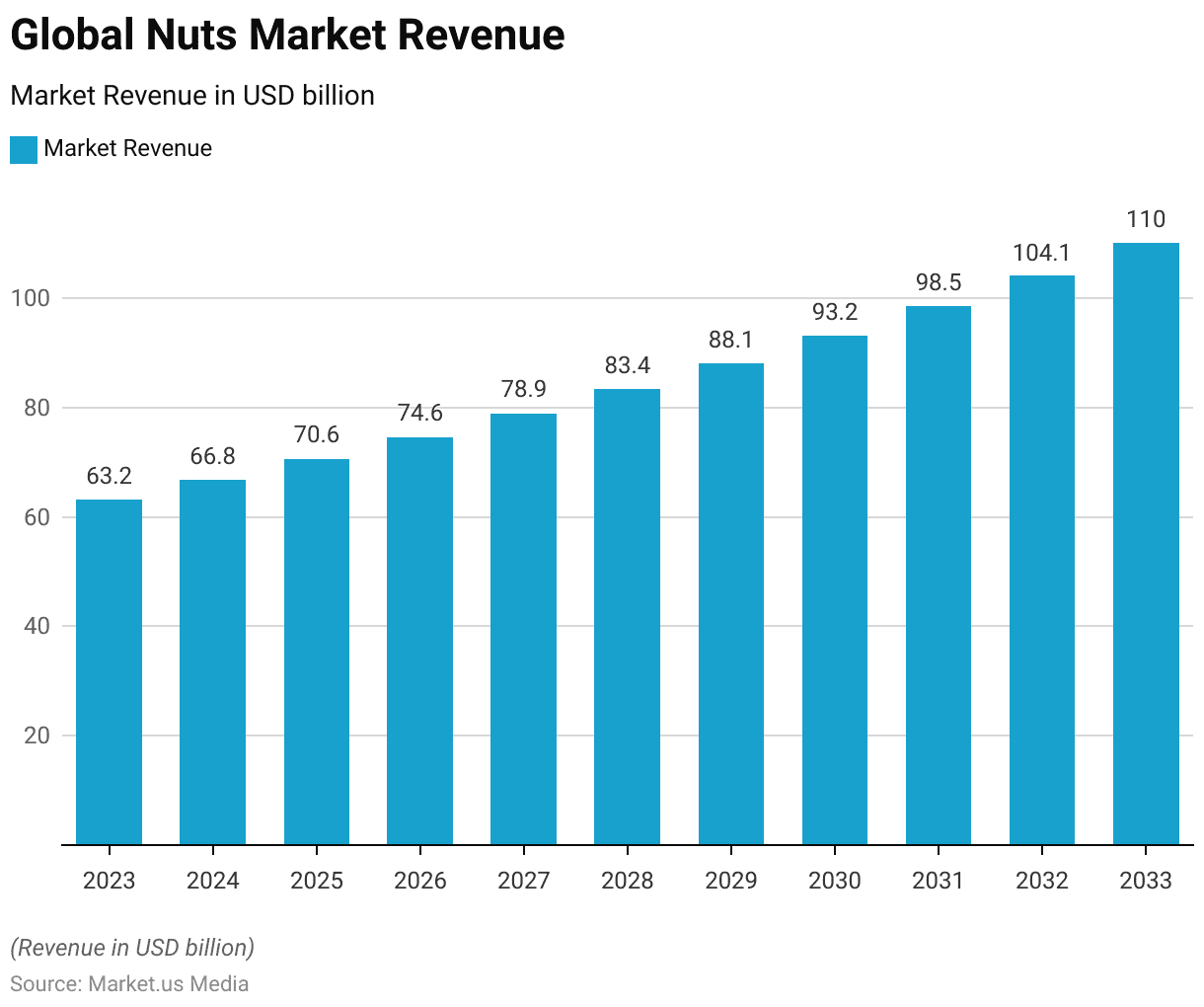
Nuts Market Share – By Distribution Channel Statistics
- The distribution channels in the nuts market exhibit a notable disparity in market share.
- Offline distribution, which includes traditional brick-and-mortar stores and physical retail outlets. Commands a significant majority with a substantial market share of 84.6%.
- In contrast, the online distribution channel, encompassing e-commerce platforms and digital retail channels, holds a comparatively smaller market share of 15.4%.
- This distribution pattern underscores the continued dominance of traditional offline channels in the nuts market. While online channels represent a growing but still relatively modest segment of the market.
(Source: Market.us)
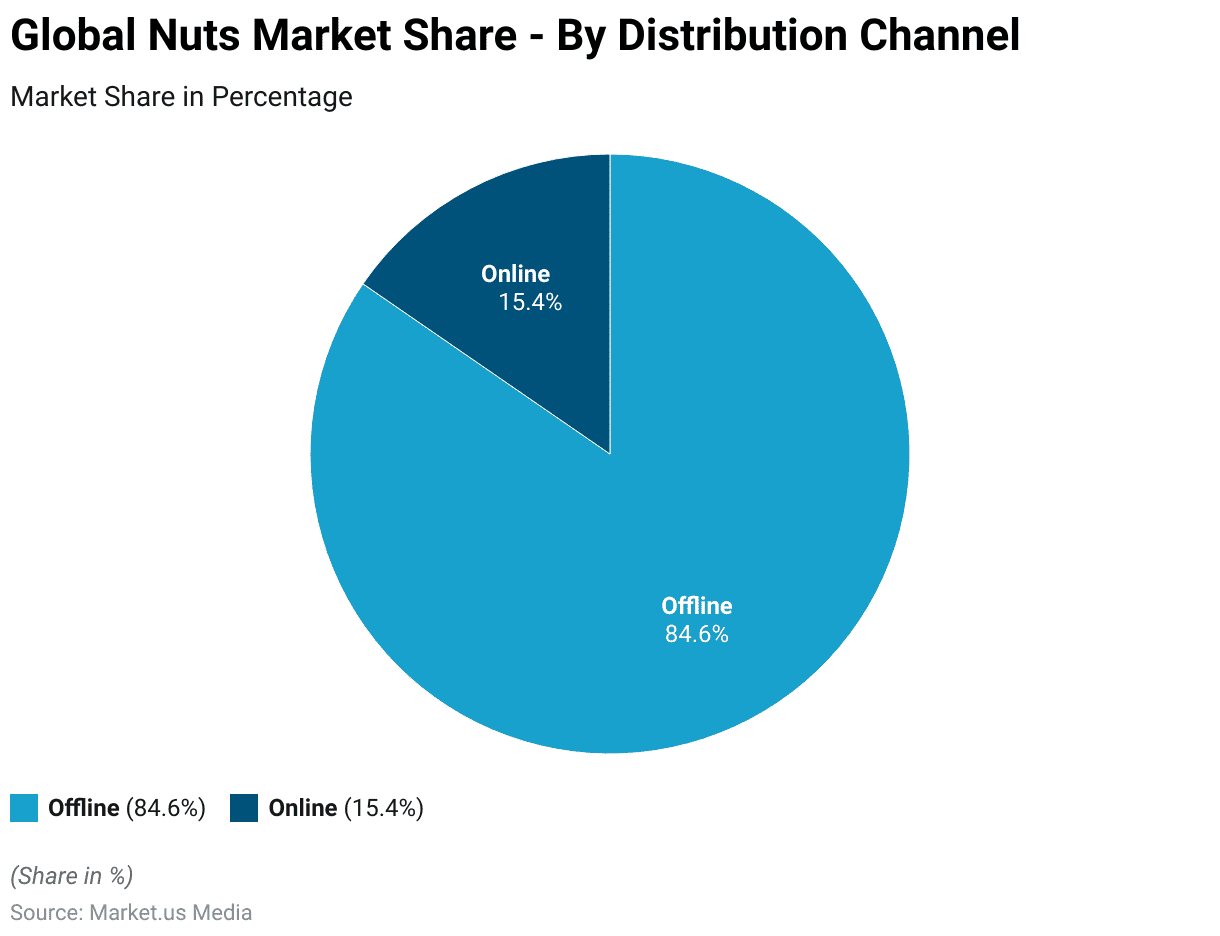
Global Nuts and Seeds Market Revenue – By Regional Statistics
- The global nuts and seeds market has demonstrated consistent growth from 2019 to 2026, with each region contributing to its expansion.
- In 2019, North America led the way with a market value of 7,639 million U.S. dollars, and this figure steadily increased year by year, reaching 10,764 million U.S. dollars in 2026.
- Europe, on the other hand, began with a market value of 6,396 million U.S. dollars in 2019 and witnessed a continuous upward trend, culminating in a value of 8,459 million U.S. dollars in 2026.
- The Asia-Pacific region displayed remarkable growth throughout this period, starting at 8,303 million U.S. dollars in 2019 and surging to an impressive 15,904 million U.S. dollars in 2026, making it a substantial contributor to the global market.
- The Rest of the World region also experienced growth, albeit at a slightly slower pace. Starting at 2,494 million U.S. dollars in 2019 and reaching 3,625 million U.S. dollars in 2026.
- Overall, these figures highlight the global expansion of the nuts and seeds market, with Asia-Pacific emerging as a significant growth driver. North America, Europe, and the Rest of the World regions also demonstrate steady increases in market value over this period.
(Source: Statista)
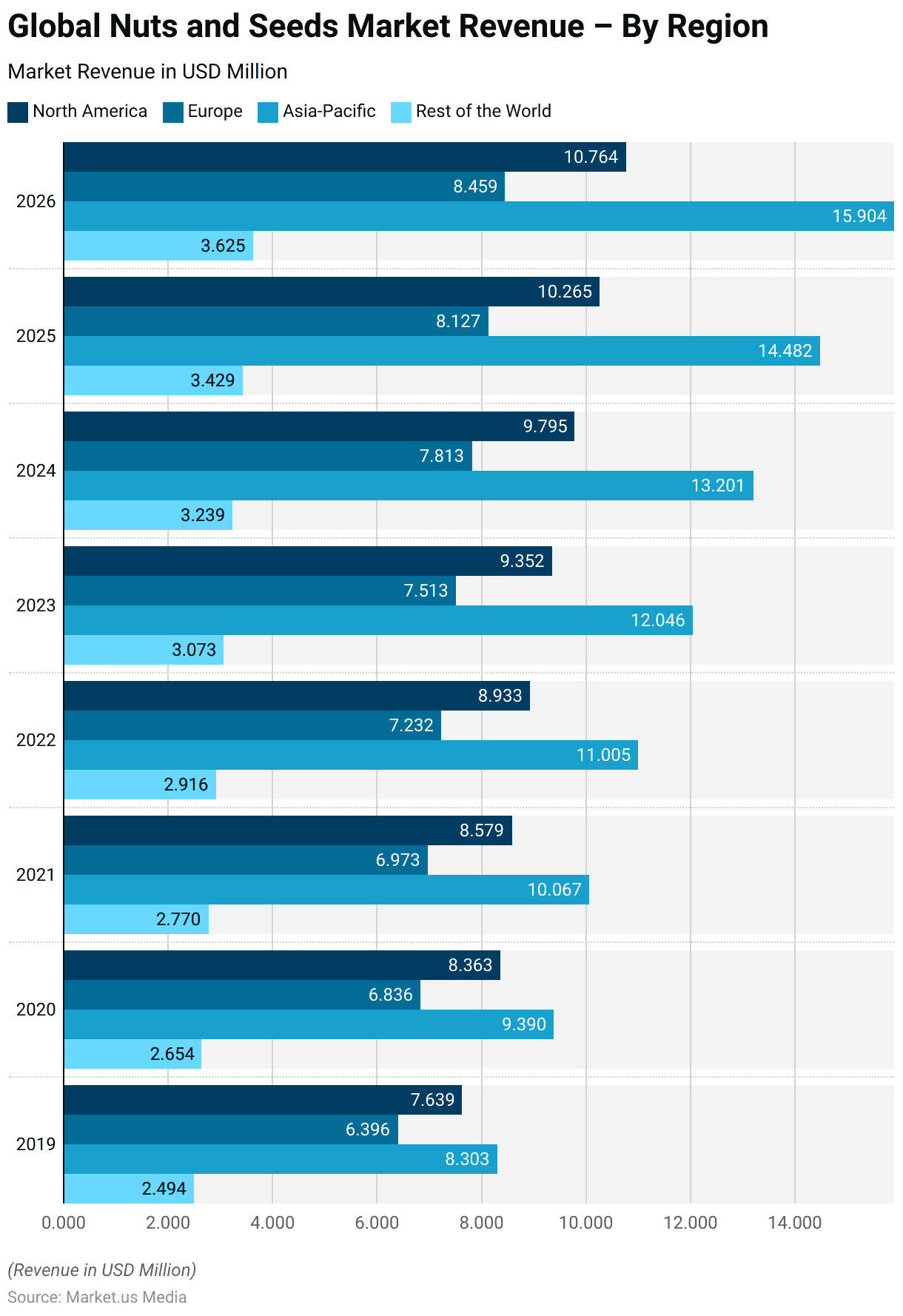
Nutritional Value of Nuts Statistics
- FoodData Central provides comprehensive nutritional information for “Nuts, mixed nuts, oil roasted, with peanuts, with salt added (SR Legacy, 168600)” in a 100-gram portion.
- This nut and seed product contains 2.08 grams of water and provides an energy value of 607 calories (equivalent to 2540 kJ).
- It is rich in protein, with 20 grams per 100 grams, and offers a substantial fat content of 54 grams. Including saturated, monounsaturated, and polyunsaturated fats.
- Carbohydrates are present at 21 grams, with dietary fiber accounting for 7 grams and total sugars at 4.15 grams, which include various types such as sucrose and glucose.
- The product also contains essential minerals like calcium, iron, magnesium, and vitamins such as thiamin, riboflavin, and niacin.
- Furthermore, it is notable for its amino acid composition, including arginine, leucine, and glutamic acid.
(Source: FoodData Central)
Global Nuts Production Statistics
Almond Production
- The global almond production on a kernel basis has experienced notable fluctuations over the past decade.
- In the 2012-2013 season, almond production stood at approximately 1,072,135 metric tons, and it continued to hover around this range in the subsequent years.
- However, there was a modest increase in production in the 2013-2014 season, reaching 1,097,228 metric tons.
- The following years saw some variations, with production levels fluctuating between 1,058,925 metric tons (2014-2015) and 1,180,779 metric tons (2016-2017).
- Subsequently, global almond production witnessed a consistent upward trend. surpassing 1,400,000 metric tons in the 2019-2020 season and further surging to an impressive 1,738,700 metric tons in the 2020-2021 season.
- However, the 2021-2022 and 2022-2023 seasons saw a decline in almond production. With figures of 1,675,839 metric tons and 1,477,505 metric tons, respectively.
- These fluctuations in almond production reflect the dynamic nature of the industry. Influenced by various factors including weather conditions, market demand, and agricultural practices.
(Source: INC International Nut and Dried Fruit Council, 2023)

Brazil Nuts Production
- Brazil nut production has displayed a diverse pattern over the past decade, reflecting various factors impacting the industry.
- In the 2012-2013 season, production reached 28,880 metric tons, but it began to fluctuate in the subsequent years.
- A decline was observed in the 2013-2014 season, with production dropping to 26,850 metric tons, followed by a slight recovery in the 2014-2015 season at 28,500 metric tons.
- However, the years 2015-2016 through 2017-2018 saw a relatively stable production range, hovering around 27,850 to 14,200 metric tons.
- A significant spike occurred in the 2018-2019 season, reaching 38,500 metric tons. But this was followed by a notable decrease in the 2019-2020 season to 26,100 metric tons.
- The subsequent years displayed some level of stability, with production figures ranging from 29,700 metric tons in 2020-2021 to 25,000 metric tons in 2021-2022.
- The 2022-2023 season witnessed a moderate increase in Brazil nut production, reaching 28,000 metric tons.
- These fluctuations highlight the influence of environmental factors, market demand, and other variables on Brazil nut production in this timeframe.
(Source: INC International Nut and Dried Fruit Council, 2023)
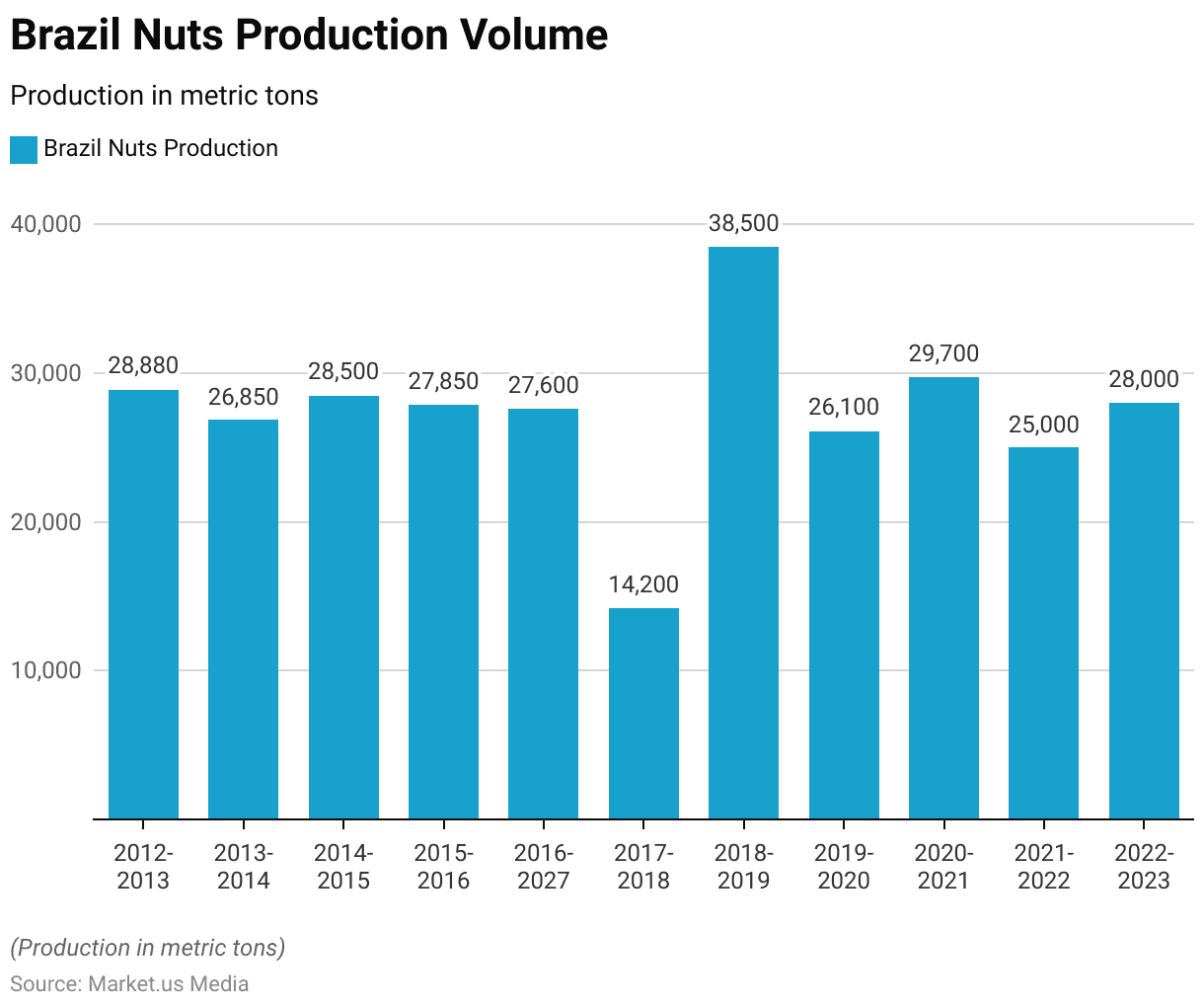
Cashews Production
- Cashew production has shown a significant and consistent upward trend over the past decade. In the 2012-2013 season, cashew production started at 549,692 metric tons and steadily increased year by year.
- The following seasons witnessed remarkable growth, with production levels reaching 601,642 metric tons in 2013-2014 and 716,682 metric tons in 2014-2015.
- This positive trajectory continued, with production figures surpassing 7 million metric tons in the 2015–2016 season and further rising to 7,83,994 metric tons in the 2016-2017 season.
- Subsequent years also maintained high levels of cashew production, consistently exceeding 7 million metric tons.
- Notably, in the 2021-2022 season, cashew production witnessed a substantial surge. Reaching an impressive 10,86,270 metric tons, and this growth trend continued into the 2022-2023 season, with production hitting 10,95,030 metric tons.
- These substantial increases in cashew production underscore the industry’s robust performance and its importance in the global market.
(Source: INC International Nut and Dried Fruit Council, 2023)
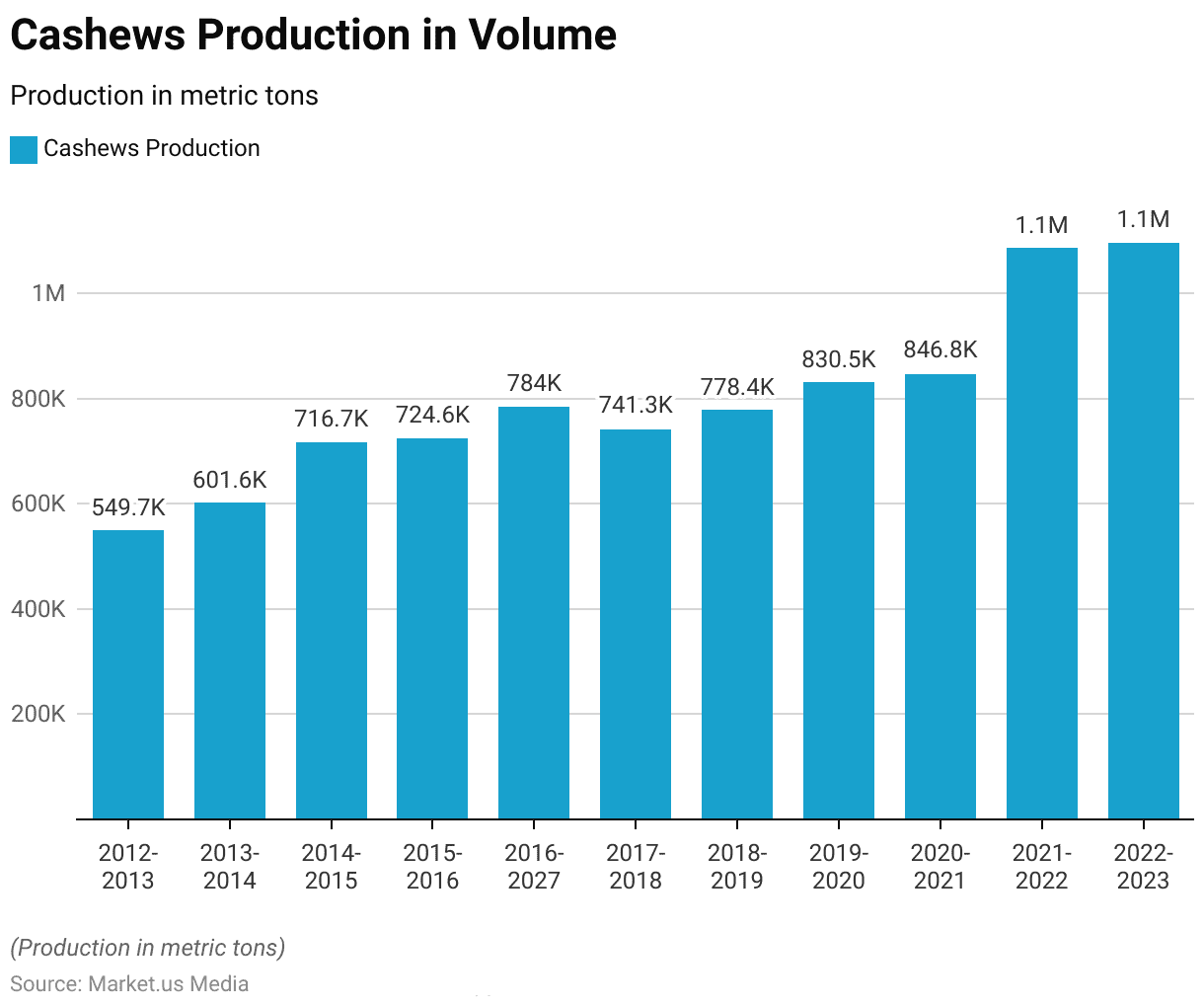
Nuts Consumption Statistics
Almond Consumption
- In 2021, almond consumption exhibited varying patterns across different countries, reflecting the diverse preferences and culinary habits of consumers worldwide.
- The United States led in almond consumption, with a substantial 3,30,258 metric tons consumed, underscoring its popularity among American consumers.
- India followed with 1,61,590 metric tons, indicating a significant appetite for almonds in the Indian market.
- Spain and China also demonstrated notable almond consumption, with 1,03,935 metric tons and 94,947 metric tons, respectively.
- Germany and Italy contributed to European almond consumption, consuming 86,933 metric tons and 62,841 metric tons, respectively.
- In Asia, Japan registered 49,047 metric tons of almond consumption, while France accounted for 46,123 metric tons in Europe.
- Furthermore, Morocco and the Netherlands exhibited their appreciation for almonds. With consumption figures of 39,945 metric tons and 38,793 metric tons, respectively.
- These consumption figures reflect the global appeal of almonds as a versatile and nutritious snack, culinary ingredient, and dietary choice across a range of countries and cultures.
(Source: INC International Nut and Dried Fruit Council, 2023)
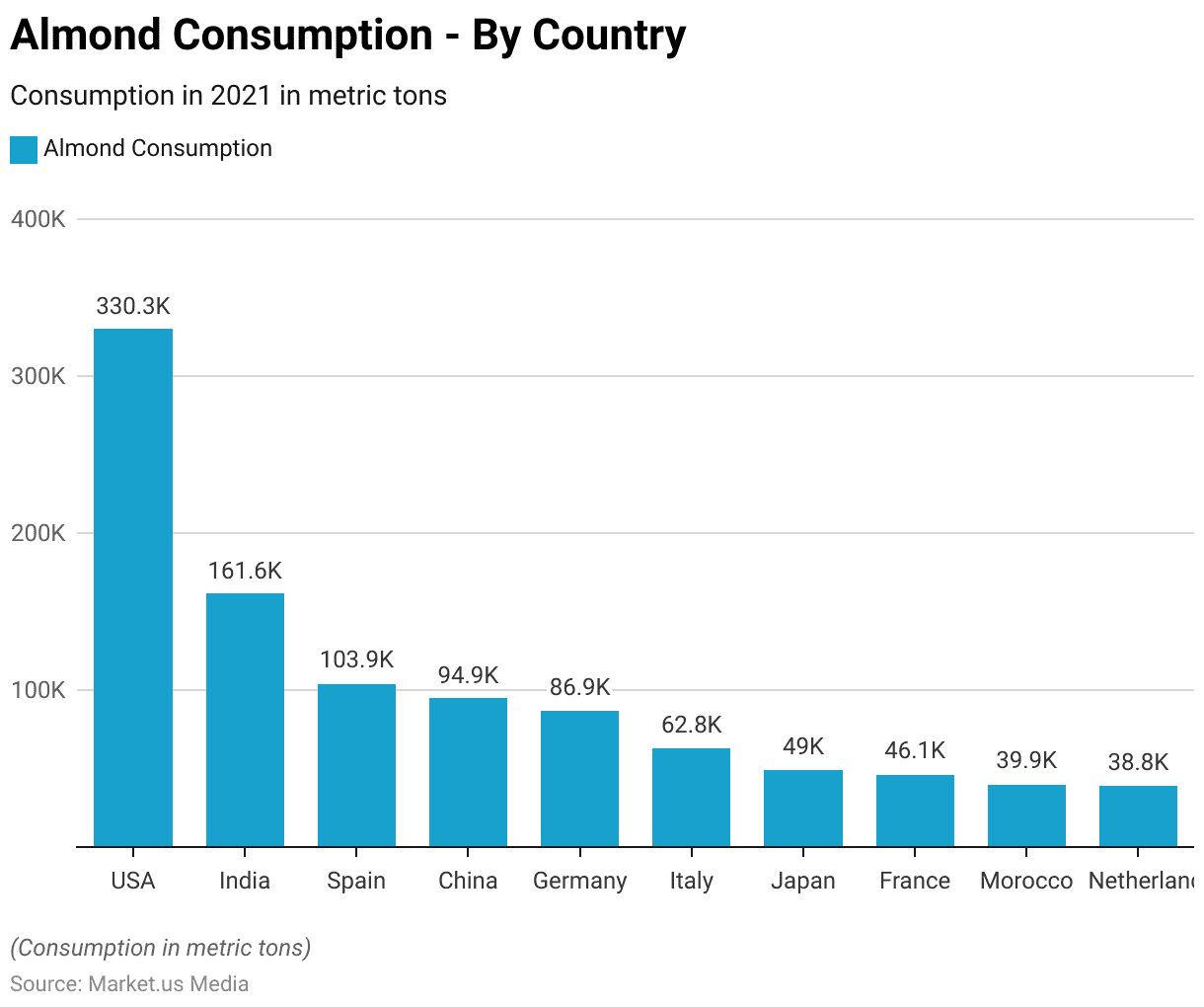
Brazil Nuts Consumption
- In the year 2021, Brazil’s nuts consumption exhibited varying preferences across several countries. Highlighting their global appeal as a nutritious and flavorful snack.
- The United States led in Brazil’s nuts consumption, with a notable 6,390 metric tons consumed. Indicating a strong demand for these nuts among American consumers.
- The Netherlands closely followed with 6,385 metric tons, reflecting their popularity in the Dutch market.
- Germany and the United Kingdom also demonstrated significant Brazil nuts consumption, with 3,634 metric tons and 3,500 metric tons, respectively.
- South Korea, Russia, and Canada displayed a growing interest in Brazil nuts, with consumption figures of 2,101 metric tons, 1,342 metric tons, and 1,315 metric tons, respectively.
- France, Colombia, and Vietnam also contributed to global consumption, with figures of 1,147 metric tons, 1,121 metric tons, and 956 metric tons, respectively.
- These consumption figures highlight the versatility and desirability of Brazil nuts across diverse international markets.
(Source: INC International Nut and Dried Fruit Council, 2023)
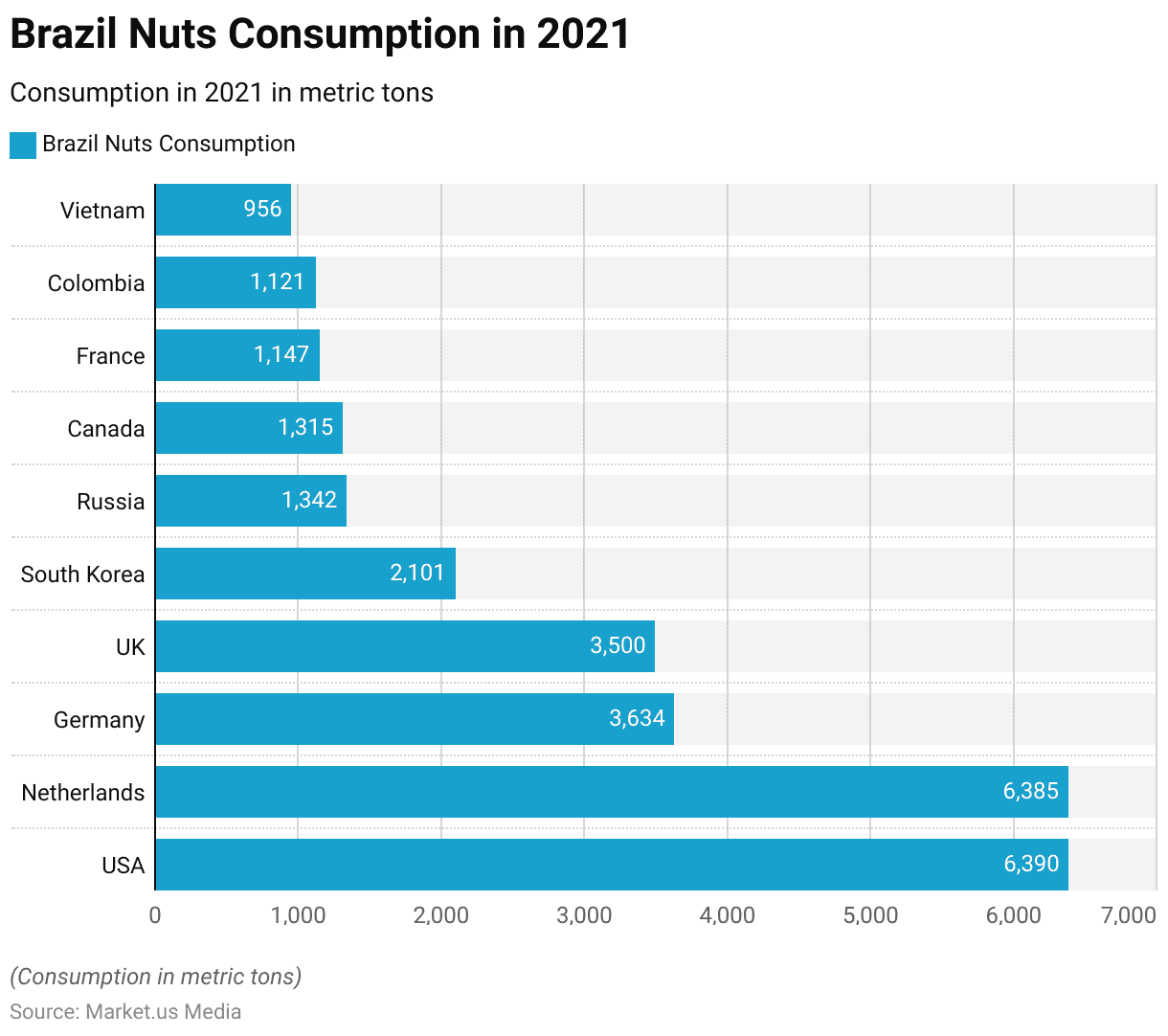
Cashews Consumption
- In 2021, cashew consumption exhibited varying trends across several countries, reflecting the widespread popularity of these nutritious nuts.
- India led the way in cashew consumption, with a substantial 3,22,160 metric tons consumed, indicating a strong affinity for cashews in the Indian market.
- The United States followed with 1,82,814 metric tons, underscoring their popularity among American consumers.
- Germany, China, and the United Kingdom also displayed notable cashew consumption figures, with 53,621 metric tons, 35,063 metric tons, and 22,589 metric tons, respectively.
- France, Canada, Australia, and Russia contributed to global cashew consumption with figures ranging from 17,321 metric tons to 15,623 metric tons.
- Italy rounded out the list with 13,905 metric tons consumed.
- These figures illustrate the widespread appeal of cashews as a versatile and healthy snack option enjoyed by consumers across various countries and culinary traditions.
(Source: INC International Nut and Dried Fruit Council, 2023)

Consumer Preferences in Nuts Consumption Statistics
- According to the findings of a Health Digest poll involving 610 participants, it appears that different people have varying preferences when it comes to healthy nuts.
- Out of the respondents, 7.38% expressed a preference for walnuts.
- Meanwhile, Brazil nuts considered a less popular choice, garnered the favor of only 8.36% of respondents.
- Pecans were the preferred healthy nut for 9.67% of participants, while 18.52% leaned toward pistachios. Almonds came in as the preferred choice for 24.92% of respondents.
- Finally, cashews emerged as the clear winner, with 31.15% of respondents declaring them their top choice among healthy nuts in the poll.
(Source: Health Digest)
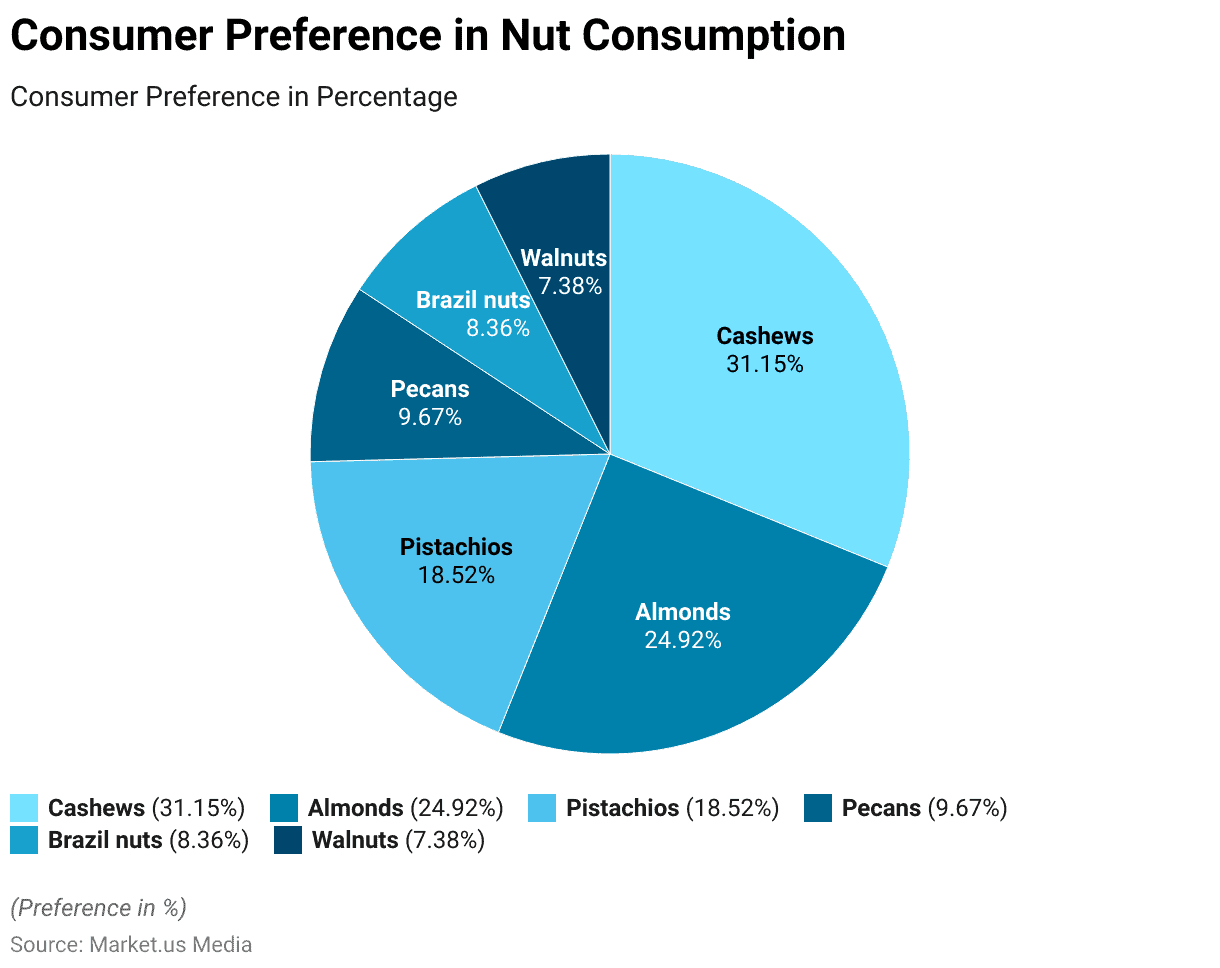
Food Safety Regulations for Nuts Statistics
- For Groundnut kernels, Moisture content should not exceed 7.0%.
- Damaged kernels, including slightly damaged ones, should not make up more than 5.0% of the batch, and aflatoxin content should not exceed 30 parts per billion.
- For Raisins, moisture content should not exceed 15.0%.
- Damaged raisins (sunburned, scarred, mechanically damaged) should not exceed 2.0%, and sugared raisins (those with visible sugar crystals) should not exceed 15.0%.
- For pistachio nuts, moisture content should not exceed 7.0%.
- Unopened shells (shells with kernels inside) should not exceed 2.0% and empty shells (shells without developed kernels) should not exceed 1.0%.
- For Dates, moisture content should not exceed 30.0% and ash insoluble in dilute HCl should not exceed 0.1%.
- Blemished or damaged units should not exceed 5.0% and Extraneous matter (e.g., stalks, shells, pits, peel) should not exceed 1.0%.
- For dry fruits and nuts, the extraneous vegetable matter should not exceed 1.0%.
- Damaged or discolored units should not exceed 2.0% and the acidity of extracted fat expressed as oleic acid should not exceed 1.25%.
(Source: FSSAI)
Recent Developments
Acquisitions and Mergers:
- The nuts industry has seen significant M&A activity as companies seek to expand their market reach and diversify their product portfolios. Notable transactions have involved major players aiming to consolidate their positions in the market and extend their operational efficiencies.
- Acquisition of a leading nut processing facility by a global food conglomerate in September 2023, expanding their portfolio of snack products.
- Merger between two nut growers and distributors in December 2023, consolidating their supply chains and distribution networks.
New Product Launches:
- Introduction of flavored nut mixes featuring innovative seasoning blends by snack companies in January 2024, offering unique taste experiences to consumers.
- Launch of single-serve nut packs for on-the-go snacking by nut brands in March 2024, catering to the growing demand for convenient and portable snack options.
Funding Rounds:
- Series C funding round for a nut butter startup specializing in artisanal nut spreads in February 2024, raising $40 million to expand production capacity and distribution channels.
- Seed funding for a sustainable nut farming initiative in April 2024, securing $12 million for research and development of eco-friendly farming practices.
Investment Landscape:
- Venture capital investments in nut startups totaled $3 billion in 2023, with a focus on companies offering innovative nut-based products and sustainable farming practices.
- Strategic partnerships and acquisitions between nut brands, food retailers, and wellness companies accounted for 60% of total investment activity in the nut market in 2023, reflecting industry efforts to capitalize on the growing popularity of nuts as a healthy and versatile snack option.
Sustainability Initiatives:
- Sustainability continues to be a key focus, with companies investing in environmentally friendly practices. This includes adopting sustainable farming practices and improving packaging to reduce environmental impact.
Conclusion
Nuts Statistics – In summary, the nuts industry offers a diverse range of nutritious seeds encased in hard shells, appealing to global consumers for their health benefits and versatility in various dishes and snacks.
While the future of this industry appears promising with projected revenue growth, it also faces challenges like climate change impacts and allergen concerns.
Stringent regulations ensure product safety and quality. As consumer preferences lean toward healthier and natural food choices, the nuts industry is well-placed to meet these demands and thrive in the evolving global food market.
FAQs
Nuts are edible seeds enclosed in hard shells. They are botanically classified as dry fruits that contain a single seed.
Common nuts include almonds, walnuts, cashews, pistachios, peanuts, and Brazil nuts.
Nuts are rich in protein, healthy fats (monounsaturated and polyunsaturated), fiber, vitamins (such as vitamin E), and minerals (like magnesium and potassium). They are also a source of antioxidants.
Nuts can be enjoyed as a snack, added to salads, used in cooking and baking, and even blended into nut butter or milk alternatives.
Yes, nuts are associated with various health benefits, including heart health, weight management, and reduced risk of chronic diseases like diabetes. Their unsaturated fats are particularly beneficial.
Discuss your needs with our analyst
Please share your requirements with more details so our analyst can check if they can solve your problem(s)



